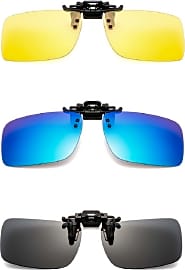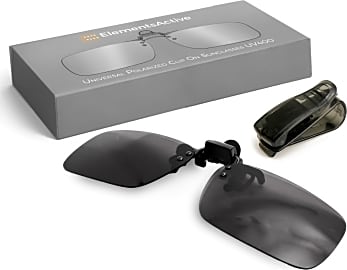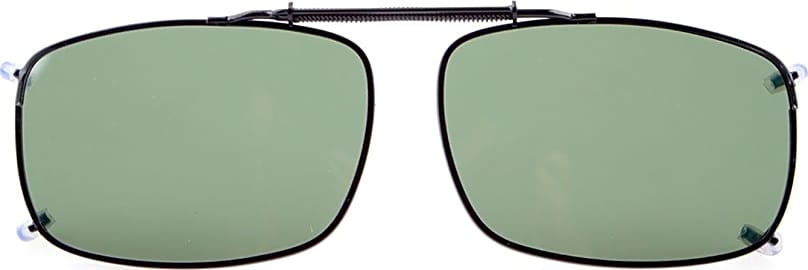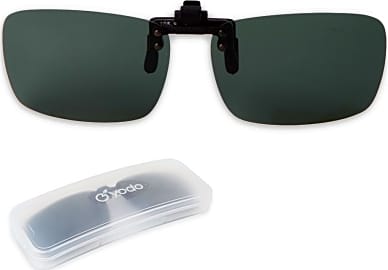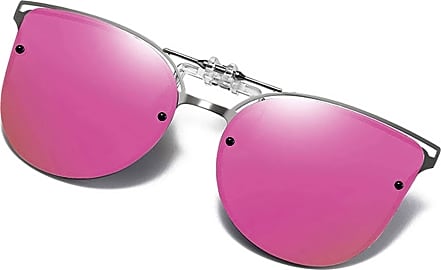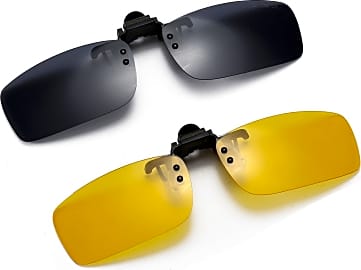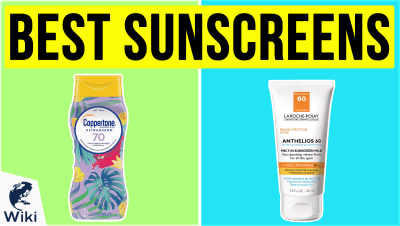The 10 Best Clip-on Sunglasses

This wiki has been updated 29 times since it was first published in April of 2018. Squinting into the bright sun is not only uncomfortable, it can be damaging to your eyes and dangerous when you're driving. But when you wear prescription glasses, you can't just whip them off and put on a pair of regular shades. That's where these clip-on sunglasses come in. They slot tightly over your existing frames to give your eyes instant relief from glare and UV rays. When users buy our independently chosen editorial recommendations, we may earn commissions to help fund the Wiki.
Editor's Notes
November 06, 2020:
Any beachgoer can tell you that a set of shades is a fashion accessory as well as a way to protect your eyes, and you shouldn't have to give up on style in order to wear your prescription glasses in the sun. That's why we've added the Bauhaus Polarized, which are offered in several elegant designs while still providing excellent glare reduction and securing snugly over your normal eyewear. They can also fold in half to slip inside a padded pocket-sized carrying case, making them extra portable.
The FF Frazala Polarized Anti-Glare are another attractive new pair, available in bright pink, turquoise, yellow, and orange in addition to the usual black and brown. We've also replaced the WearMe Pro Fashion with the Dollger Steampunk, a similar vintage design with a wider variety of color options. And we swapped out the Splaks Unisex in favor of the Litbun 3 Pack Flip Up, which offers a third pair of lenses at a price that's only a tiny bit higher, and features an anti-reflective coating that the Splaks lack.
Our final substitution was to drop the Tacloft Sports in favor of the upgraded Tacloft Alloy Unisex, a highly durable pair of shades that are perfect for use in outdoor adventures. We also got rid of the Weluk Wayfarer, after noticing a number of customer reports that the clip tends to protrude into the forehead.
If you're planning on spending time in the sun, you'll want a good bottle of sunscreen as well as eye protection, and a quality sun hat wouldn't be a bad idea either. We've also compiled a list of straps and cords to keep your frames around your neck, in case you're worried about losing them.
July 05, 2019:
The most important thing to consider when shopping for sunglasses, including clip-ons, is the degree of protection they offer from the sun's harmful ultraviolet (UV) rays, which are categorized in two types--UVA and UVB. Your eyes and eyelids can be damaged by the sun, and sunglasses that offer UV protection are like sunscreen for your eyes. Look for models that are rated at UV400, which means they block 100% of UV rays, both UVA and UVB. Lens polarization is also popular since it helps reduce glare, but it can make some digital displays difficult to read.
Everybody needs to protect their eyes from the sun. Fortunately, expensive prescription sunglasses or large ones that cover your regular glasses are not your only options. Clip-on sunglasses come in a large array of styles and colors, as reflected in our selections, and you can find a clip-on that meets your needs. In this update, we favored models that offer 99 or 100 percent UV protection while still looking good. Promoted the Eyekepper Easyclip to one of our top slots because of its reputation with users, ease of use, and the full protection it offers.
Special Honors
Jins Switch This innovative lens crafting company ensures that your detachable shades fit perfectly on your prescription frames by building them at the same time. The sunglass attachment is matched precisely to the shape of the rims, locking in place with discreet magnetic contact points. Jins offers a virtual try-on option to let you use a selfie to preview how your order will look, as well as free in-store adjustment if it doesn't fit right. jins.com
The Three Main Types Of Clip-On Sunglasses
There are three main types of clip-on sunglasses: traditional, flip-ups, and magnetic.
While their name might make it somewhat obvious what this product does, let's quickly go over how clip-on sunglasses work and the different varieties that exist. For those unfamiliar with them, it's worth noting that they aren't actually full sunglasses, as they do not contain arms. Clip-ons are simply lenses that you use in conjunction with your standard eyeglasses. They go directly over your prescription eyewear, so you don't need to choose between enhanced vision or UV protection — a nuisance that causes many to, unfortunately, just forego UV protection entirely, which can lead to issues later in life like cataracts.
There are three main types of clip-on sunglasses: traditional, flip-ups, and magnetic. The traditional variety have a clip at the center of the bridge that clamps onto the corresponding part of your eyeglasses' frame. When you no longer need them, traditional models must be entirely removed from your prescription eyewear.
Busier individuals might appreciate flip-ups, since these do not have to be reattached each time sun protection is needed. Instead, they can stay permanently affixed to your prescription glasses and you simply flip them up or down as needed. These might be a good option for preventing dangerous sun glare while on the road, since motorists can rapidly flip them down and up with one hand as lighting conditions change for safer driving. Such lenses also generally clip onto the bridge of your frames, just like the traditional variety.
Possibly the easiest clip-on sunglasses to attach and detach would be the magnetic variety. These are a good choice for those who like the look of their original frames, since you can have them designed to the exact specification of your prescription eyewear. As you can probably gather from the name, these feature magnets that stick to the frame around your prescription lenses. Though they're part of the clip-on family, there is no actual clasp of any kind involved in their design.
The Perks Of Clip-Ons Versus Standard Sunglasses
You may be wondering why you should get clip-on lenses rather than just purchasing a pair of prescription sunglasses. There are a lot of benefits to simply adding clip-ons to your existing frames. For starters, if you go with the flip-up kind, you don't need to carry extra eyewear around all the time. When your beach bag is already full of belongings, you won't need to also stuff a pair of shades inside, which are probably also housed inside a bulky case. Your UV lenses will be sitting securely on your regular ones to use as you need them.
There are a lot of benefits to simply adding clip-ons to your existing frames.
Even if carrying an extra pair of glasses is no trouble to you, clip-on lenses are still more convenient than standard ones for anyone who frequently switches between indoor and outdoor settings. It's much quicker and easier to flip your clip-ons up and down than it is to completely remove your prescription eyewear, put those in a case, and retrieve your sunglasses, or visa versa, every time you transition from inside to outside.
Purchasing prescription sunglasses is also quite expensive, and likely won't be covered by most of the limited vision insurance policies Americans have. You probably already shelled out a great deal of money for your standard corrective eyewear, and doing so all over again for lenses with UV protection can be financially painful. Simply adding UV protective clip-on lenses to your current glasses is comparatively quite affordable. As an added perk, your clip-on lenses can help protect your more expensive prescription ones from scratches, too.
Polarized Versus Non-Polarized Clip-Ons
When it comes time to select your clip-on sunglasses, you'll be faced with the decision of polarized or non-polarized varieties. Opting for the polarized kind isn't automatically a good thing. It will depend entirely on how you plan on using your eye protection. Both polarized and non-polarized sunglasses protect against bright light, powerful UVA, and UVB light, but polarized sunglasses rely on an optical filter called a polarizer, which blocks out particular light waves that cause blurry vision and haze. The sensitivity of your eyes and your environment will dictate when such a filter is necessary.
The sensitivity of your eyes and your environment will dictate when such a filter is necessary.
Polarized clip-ons are going to be important in high-glare situations. These types of clip-ons filter out the glare that can occur when sunlight reflects off surfaces. One can quickly think of scenarios when this happens, like skiing, boating, or simply walking through a metropolitan area with skyscrapers full of shiny windows. Light can reflect off snow, water, or glass and sometimes the glare can be so bright that it is blinding. Polarized lenses can help prevent this. If your only concern is reducing the brightness of light entering your eyes, however, then non-polarized varieties are fine.
It is worth noting that there is one big disadvantage to wearing polarized sunglasses. Many of the devices we look at in our daily lives such as smartphones, laptops, and the displays on our dashboards contain the same filters as polarized sunglasses. When the two interact in a certain way, they can completely block out light, making whatever we are looking at appear dark. If you have ever been wearing a pair of polarized sunglasses and noticed that you can see the images on your phone or camera screen if you hold the device one way, but it goes completely dark when your rotate it horizontally, you have experienced it. This is why airline pilots are discouraged from wearing such lenses, since it can make it difficult for them to differentiate their control panels. This also means it can make it difficult to see the TV at your favorite outdoor sports bar. Additionally, polarized sunglasses also tend to be more expensive than non-polarized varieties, so just make sure they're right for your purposes before making the investment.


